The Urban Seismic Observatory of Catania (Italy): A Real-Time Seismic Monitoring at Urban Scale
Abstract
1. Introduction
1.1. Urban Seismic Network and Structural Health Monitoring (SHM)
1.2. Why an Urban Seismic Observatory in Catania?
2. Method
2.1. OSU-CT: The Urban Seismic Observatory in the City of Catania
2.2. Hardware Design
2.2.1. The OSU-AQ2 Data Logger
- A 24-bit, 16-channel (multiplexed) delta-sigma analog to digital converter (ADC) ADS1258 from Texas Instruments;
- An analog interface with a very low noise programmable gain amplifier PGA281 from Texas instruments and passive low-pass 100 Hz antialiasing filters;
- A microcontroller Arm Cortex M4 MCU 80 MHz STM32F405, which has three main functions: reading samples from the analog and digital sensors, generating a data frame including the sample number and timestamp, and finally transmitting data to a single board computer (SBC).
2.2.2. Sensors: Velocimeter and MEMS Accelerometers
- The ADXL355 (analog device) is a high-performance three-axis Class C MEMS accelerometer. Output is 20 bits for acceleration data and its dynamic range can be selected by initial SPI commands (±2/4/8 g) and ±2 g is used in our case. It presents a digital SPI or I2C interface (SPI is used in our case) and has an output resolution of 3.9 µg/LSB (on average at ±2 g). This sensor is connected to the OSU-AQ2 device using an SPI interface for communication (Figure 6). The accelerometer also has other digital interface signals (INT1, INT2, and DRDY), which are used for additional communication with microcontroller and SBC.
- The M-A352 (Seiko Epson Corporation, San Jose, CA, USA) high-sensitivity, ultra-low noise, and low-power digital Q-MEMS accelerometer, features among the highest resolution levels in this class of commercial accelerometers. The M-A352 output of 30-bit (24 effective) has a resolution of 0.06 µg/LSB (average) with a wider dynamic range of ±15 g while supporting a frequency bandwidth up to 400 Hz. The M-A352 can be connected to the OSU-AQ2 device using an SPI interface in the same way as the ADXL355 (Figure 6).
3. Results
3.1. OSU-CT Earthquake Detection
3.2. The 23 December 2021 Catania Plain Earthquake: The First Shakemap at Urban Scale in Italy
4. Conclusions
Author Contributions
Funding
Data Availability Statement
Acknowledgments
Conflicts of Interest
References
- Evans, J.R.; Allen, R.M.; Chung, A.I.; Cochran, E.S.; Guy, R.; Hellweg, M.; Lawrence, J.F. Performance of Several Low-Cost Accelerometers. Seismol. Res. Lett. 2014, 85, 147–158. [Google Scholar] [CrossRef]
- Fu, J.; Li, Z.; Meng, H.; Wang, J.; Shan, X. Performance Evaluation of Low-Cost Seismic Sensors for Dense Earthquake Early Warning: 2018–2019 Field Testing in Southwest China. Sensors 2019, 19, 1999. [Google Scholar] [CrossRef] [PubMed]
- Rovithis, E.; Makra, K.; Savvaidis, A.; Kirtas, E. The accelerometric network of the Indes-Musa project in the Kalochori area: Configuration, documentation and preliminary data interpretation, Proceedings of the 14th International Congress, Thessaloniki May 2016. Bull. Geolog. Soc. Greece 2016, 50, 1110–1119. [Google Scholar]
- Pierleoni, P.; Marzorati, S.; Ladina, C.; Raggiunto, S.; Belli, A.; Palma, L.; Cattaneo, M.; Valenti, S. Performance Evaluation of a Low-Cost Sensing Unit for Seismic Applications: Field Testing During Seismic Events of 2016–2017 in Central Italy. IEEE Sens. J. 2018, 18, 6644–6658. [Google Scholar] [CrossRef]
- Papanikolaou, V.K.; Karakostas, C.Z.; Theodoulidis, N.P. A Low-Cost Instrumentation System for Seismic Hazard Assessment in Urban Areas. Sensors 2021, 21, 3618. [Google Scholar] [CrossRef]
- Esposito, M.; Palma, L.; Belli, A.; Sabbatini, L.; Pierleoni, P. Recent Advances in Internet of Things Solutions for Early Warning Systems: A Review. Sensors 2022, 22, 2124. [Google Scholar] [CrossRef]
- Federici, F.; Graziosi, F.; Faccio, M.; Gattulli, V.; Lepidi, M.; Potenza, F. An integrated approach to the design of Wireless Sensor Networks for structural health monitoring. Int. J. Distrib. Sens. Netw. 2012, 8, 594842. [Google Scholar] [CrossRef]
- Lin, J.F.; Li, X.Y.; Wang, J.; Wang, L.X.; Hu, X.X.; Liu, J.X. Study of Building Safety Monitoring by Using Cost-Effective MEMS Accelerometers for Rapid After-Earthquake Assessment with Missing Data. Sensors 2021, 21, 7327. [Google Scholar] [CrossRef]
- Francisco, J.; Pallarés, M.B.; Bartoli, G.; Pallarés, L. Structural health monitoring (SHM) and Nondestructive testing (NDT) of slender masonry structures: A practical review. Constr. Build. Mater. 2021, 297, 123768. [Google Scholar] [CrossRef]
- Liang, Q.; Tani, A.; Yamabe, Y. Fundamental Tests on a Structural Health Monitoring System for Building Structures Using a Single-board Microcontroller. J. Asian Arch. Build. Eng. 2015, 14, 663–670. [Google Scholar] [CrossRef]
- Picozzi, M.; Emolo, A.; Martino, C.; Zollo, A.; Miranda, N.; Verderame, G.; Boxberger, T. and the REAKT Working, Group Earthquake Early Warning System for Schools: A Feasibility Study in Southern Italy. Seism. Res. Lett. 2015, 86, 2A. [Google Scholar] [CrossRef]
- Dolce, M.; Nicoletti, M.; De Santis, A.; Marchesini, S.; Spina, D.; Talanas, F. Osservatorio sismico delle strutture: The Italian structural seismic monitoring network. Bull. Earth. Eng. 2017, 15, 621–641. [Google Scholar] [CrossRef]
- Groos, J.C.; Ritter, J.R.R. Time domain classification and quantification of seismic noise in an urban environment. Geophys. J. Int. 2009, 179, 1213–1231. [Google Scholar] [CrossRef]
- Diaz, J.; Schimmel, M.; Ruiz, M.; Carbonell, R. Seismometers Within Cities: A Tool to Connect Earth Sciences and Society. Front. Earth Sci. 2020, 8, 9. [Google Scholar] [CrossRef]
- Vassallo, M.; De Matteis, R.; Bobbio, A.; Di Giulio, G.; Adinolfi, G.M.; Cantore, L.; Cogliano, R.; Fodarella, A.; Maresca, R.; Pucillo, S.; et al. Seismic noise cross-correlation in the urban area of Benevento city (Southern Italy). Geophys. J. Int. 2019, 217, 1524–1542. [Google Scholar] [CrossRef]
- Olivito, R.S.; Porzio, S.; Scuro, C.; Carnì, D.L.; Lamonaca, F. Inventory and monitoring of historical cultural heritage buildings at the territorial scale. A preliminary study of SHM based on CARTIS approach. Acta IMEKO 2021, 10, 9. [Google Scholar] [CrossRef]
- Azzara, R.M.; Girardi, M.; Iafolla, V.; Padovani, C.; Pellegrini, D. Long-Term Dynamic Monitoring of Medieval Masonry Towers. Front. Built Environ. 2020, 6, 9. [Google Scholar] [CrossRef]
- Chatzopoulos, G.; Papadopoulos, I.; Vallianatos, F.; Makris, J.P.; Kouli, M. Strong Ground Motion Sensor Network for Civil Protection Rapid Decision Support Systems. Sensors 2021, 21, 2833. [Google Scholar] [CrossRef]
- De Luca, G.; Marcucci, S.; Milana, G.; Sano, T. Evidence of Low-Frequency Amplification in the City of L’Aquila, Central Italy, through a Multidisciplinary Approach Including Strong- and WeakMotion Data, Ambient Noise, and Numerical Modeling. Bull. Seismol. Soc. Am. 2005, 95, 1469–1481. [Google Scholar] [CrossRef]
- Bindi, D.; Pacor, F.; Luzi, L.; Massa, M.; Ameri, G. The Mw 6.3, 2009 L’Aquila earthquake: Source, path and site effects from spectral analysis of strong motion data. Geophys. J. Int. 2009, 179, 1573–1579. [Google Scholar] [CrossRef]
- Sextos, A.; De Risi, R.; Pagliaroli, A.; Foti, F.; Passeri, F.; Ausilio, E.; Cairo, R.; Capatti, M.C.; Chiabrando, F.; Chiaradonna, A.; et al. Local Site Effects and Incremental Damage of Buildings during the 2016 Central Italy Earthquake Sequence. Earthq. Spectra 2019, 34, 1639–1669. [Google Scholar] [CrossRef]
- Di Giulio, G.; Azzara, R.M.; Cultrera, G.; Giammarinaro, M.S.; Vallone, P.; Rovelli, A. Effect of Local Geology on Ground Motion in the City of Palermo, Italy, as Inferred from Aftershocks of the 6 September 2002 Mw 5.9 Earthquake. Bull. Seismol. Soc. Am. 2005, 95, 2328–2341. [Google Scholar] [CrossRef]
- Nof, R.N.; Chung, A.I.; Rademacher, H.; Dengler, L.; Allen, R.M. MEMS Accelerometer Mini-Array (MAMA): A Low-Cost Implementation for Earthquake Early Warning Enhancement. Earthq. Spectra 2019, 35, 21–38. [Google Scholar] [CrossRef]
- Chung, A.I.; Cochran, E.S.; Kaiser, A.E.; Christensen, C.M.; Yildirim, B.; Lawrence, J.F. Improved rapid magnitude estimation for a community-based, low-cost MEMS accelerometer network. Bull. Seismol. Soc. Am. 2015, 105, 1314–1323. [Google Scholar] [CrossRef][Green Version]
- Clayton, R.W.; Heaton, T.; Kohler, M.; Chandy, M.; Guy, R.; Bunn, J. Community seismic network: A dense array to sense earthquake strong motion. Seismol. Res. Lett. 2015, 86, 1354–1363. [Google Scholar] [CrossRef]
- Horiuchi, S.; Horiuchi, Y.; Yamamoto, S.; Nakamura, H.; Wu, C.; Rydelek, P.A.; Kachi, M. Home seismometer for earthquake early warning. Geophys. Res. Lett. 2009, 36. [Google Scholar] [CrossRef]
- Zheng, H.; Shi, G.; Zeng, T.; Li, B. Wireless earthquake alarm design based on MEMS accelerometer. In Proceedings of the 2011 International Conference on Consumer Electronics, Communications and Networks (CECNet), Xianning, China, 16–19 April 2011; pp. 5481–5484. [Google Scholar]
- Peng, C.; Peng, J.; Chen, Q.; Ma, Q.; Yang, J. Performance Evaluation of a Dense MEMS-Based Seismic Sensor Array Deployed in the Sichuan-Yunnan Border Region for Earthquake Early Warning. Micromachines 2019, 10, 735. [Google Scholar] [CrossRef]
- Yang, B.M.; Mittal, H.; Wu, Y.-M. Real-Time Production of PGA, PGV, Intensity, and Sa Shakemaps Using Dense MEMS-Based Sensors in Taiwan. Sensors 2021, 21, 943. [Google Scholar] [CrossRef]
- Lawrence, J.F.; Cochran, E.S.; Chung, A.; Kaiser, A.; Christensen, C.M.; Allen, R.; Baker, J.W.; Fry, B.; Heaton, T.; Kilb, D.; et al. Rapid Earthquake Characterization Using MEMS Accelerometers and Volunteer Hosts Following the M 7.2 Darfield, New Zealand, Earthquake. Bull. Seismol. Soc. Am. 2014, 104, 184–192. [Google Scholar] [CrossRef][Green Version]
- Tanırcan, G.; Hakan Alçık, H.; Beyen, K. Reliability of MEMS accelerometers for instrumental intensity mapping of earthquakes. Ann. Geophys. 2017, 60 (Suppl. 6), SE673. [Google Scholar] [CrossRef]
- Holland, A. Earthquake data recorded by the MEMS accelerometer: Field testing in Idaho. Seismol. Res. Lett. 2003, 74, 20–26. [Google Scholar] [CrossRef]
- Pozzi, M.; Zonta, D.; Trapani, D.; Athanasopoulos, N.; Amditis, A.; Bimpas, M.; Garetsos, A.; Stratakos, Y.; Ulieru, D. MEMS-based sensors for post-earthquake damage assessment. J. Phys. Conf. Ser. 2011, 305, 012100. [Google Scholar] [CrossRef]
- Kim, Y.; Kang, T.S.; Rhie, J. Development and Application of a Real-Time Warning System Based on a MEMS Seismic Network and Response Procedure for the Day of the National College Entrance Examination in South Korea. Seismol. Res. Lett. 2017, 88, 1322–1326. [Google Scholar] [CrossRef]
- Peng, C.; Chen, Y.; Chen, Q.; Yang, J.; Wang, H.; Zhu, X.; Xu, Z.; Zheng, Y. A new type of tri-axial accelerometers with high dynamic range MEMS for earthquake early warning. Comput. Geosci. 2017, 100, 179–187. [Google Scholar] [CrossRef]
- Lynch, J.P.; Loh, K.J. A Summary Review of Wireless Sensors and Sensor Networks for Structural Health Monitoring. Shock Vib. Dig. 2006, 38, 91–128. [Google Scholar] [CrossRef]
- Gattulli, G.; Marco Lepidi, M.; Potenza, F. Dynamic testing and health monitoring of historic and modern civil structures in Italy. Struct. Monit. Maint. 2016, 3, 71–90. [Google Scholar] [CrossRef]
- Azzaro, R.; Barbano, M.S.; Moroni, A.; Mucciarelli, M.; Stucchi, M. The seismic history of Catania. J. Seismol. 1999, 3, 235–252. [Google Scholar] [CrossRef]
- Azzaro, R.; Barbano, M.S. Analysis of seismicity of Southeastern Sicily: Proposal of a tectonic interpretation. Ann. Geophys. 2000, 43, 171–188. [Google Scholar] [CrossRef]
- Patanè, D.; Malfitana, D.; Mazzaglia, A. Dalla conoscenza all’azione. Il progetto PON EWAS: Un sistema di allerta precoce per la salvaguardia del patrimonio culturale. In Monitoraggio e Manutenzione Delle Aree Archeologiche Cambiamenti Climatici, Dissesto Idrogeologico, Degrado Chimico-Ambientale, AA.VV. Atti del Convegno Internazionale di Studi, Roma, Curia Iulia, 20–21 Marzo 2019, Collana Bibliotheca Archaeologica; L’ERMA di BRETSCHNEIDER: Roma, Italy, 2020; Volume 65, pp. 187–197. [Google Scholar]
- Fertitta, G.; Costanza, A.; D’anna, G.; Patanè, D. The Earth Lab 5s (ETL3D/5s) seismic sensor. Design and test. Ann. Geophys. 2020, 63, 2. [Google Scholar] [CrossRef]
- Ribeiro, R.R.; Lameiras, R.M. Evaluation of low-cost MEMS accelerometers for SHM: Frequency and damping identification of civil structures. Ibero-Latin American congress on computational methods in engineering. Lat. Am. J. Solids Struct. 2019, 16, 7. [Google Scholar] [CrossRef]
- CEN European Committee for Standardization. EUROCODE 8: Design of Structures for Earthquake Resistance—Part 1: General Rules, Seismic Action and Rules for Buildings; CEN European Committee for Standardization: Bruxelles, Belgium, 2003. [Google Scholar]
- Russo, E.; Felicetta, C.; D’Amico, M.; Sgobba, S.; Lanzano, G.; Mascandola, C.; Pacor, F.; Luzi, L. Italian Accelerometric Archive v3.2—Istituto Nazionale di Geofisica e Vulcanologia, Dipartimento della Protezione Civile Nazionale; CEN: Bruxelles, Belgium, 2022. [Google Scholar] [CrossRef]
- Faenza, L.; Michelini, A. Regression analysis of MCS intensity and ground motion parameters in Italy and its application in ShakeMap. Geophys. J. Int. 2010, 180, 1138–1152. [Google Scholar] [CrossRef]
- Faenza, L.; Michelini, A. Regression analysis of MCS intensity and ground motion spectral accelerations (SAs) in Italy. Geophys. J. Int. 2011, 186, 1415–1439. [Google Scholar] [CrossRef]
- Locati, M.; Camassi, R.; Rovida, A.; Ercolani, E.; Bernardini, F.; Castelli, V.; Caracciolo, C.H.; Tertulliani, A.; Rossi, A.; Azzaro, R.; et al. Database Macrosismico Italiano (DBMI15); versione 4.0; Istituto Nazionale di Geofisica e Vulcanologia (INGV): Rome, Italy, 2022. [CrossRef]
- Magli, A.; Branca, S.; Speranza, F.; Risica, G.; Siravo, G.; Giordano, G. Paleomagnetic dating of prehistoric lava flows from the urban district of Catania (Etna volcano, Italy). GSA Bull. 2022, 134, 616–662. [Google Scholar] [CrossRef]
- Sivori, D.; Cattari, S.; Lepidi, M. A methodological framework to relate the earthquake-induced frequency reduction to structural damage in masonry buildings. Bull. Earthq. Eng. 2022, 1–36. [Google Scholar] [CrossRef]
- Kouris, L.A.S.; Penna, A.; Magenes, G. Dynamic modification and damage propagation of a two-storey full-scale masonry building. Adv. Civ. Eng. 2019, 2019, 2396452. [Google Scholar] [CrossRef]

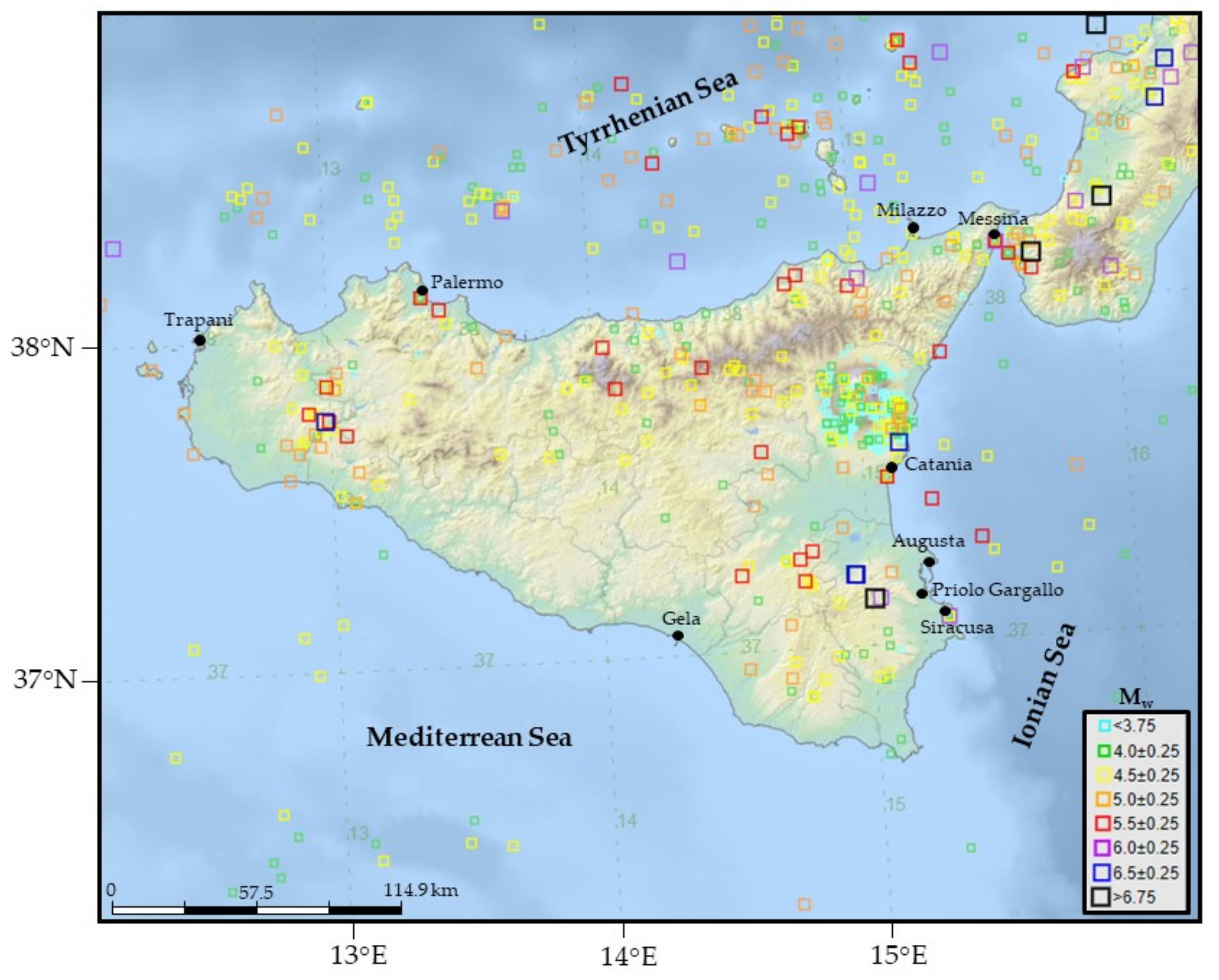
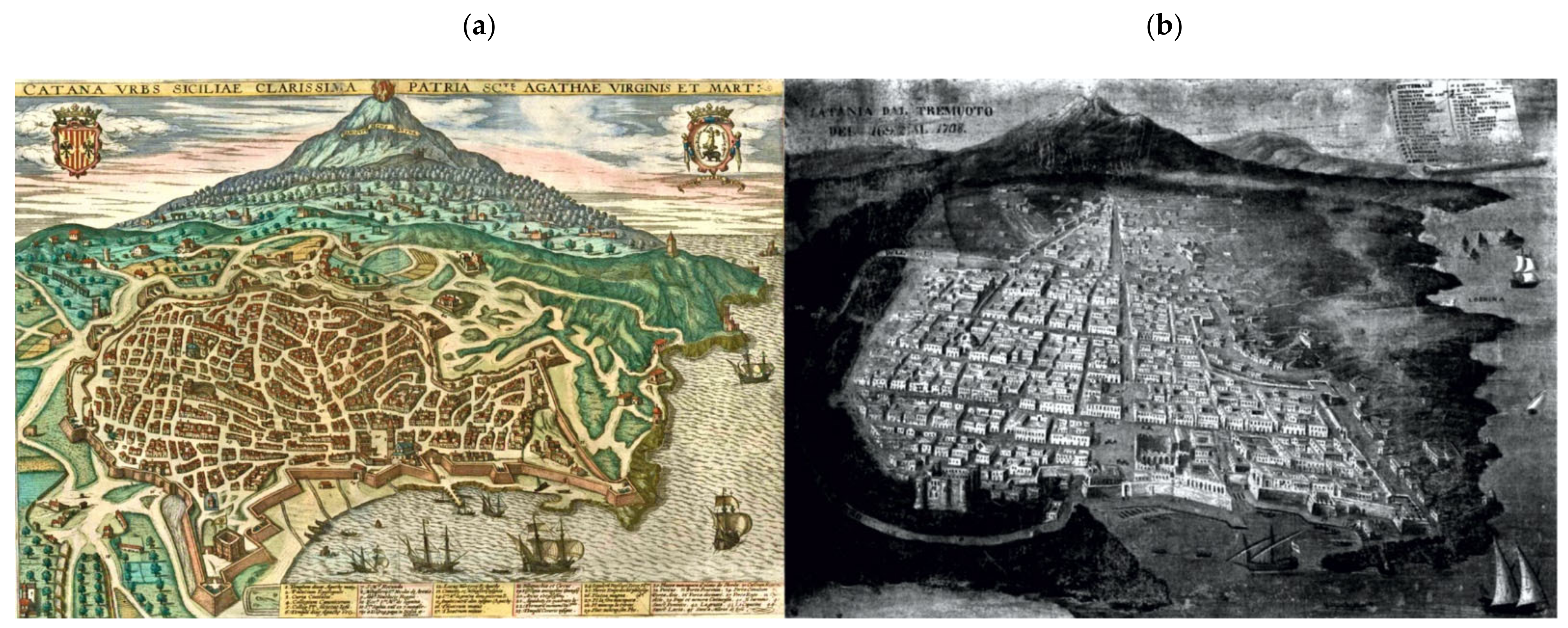
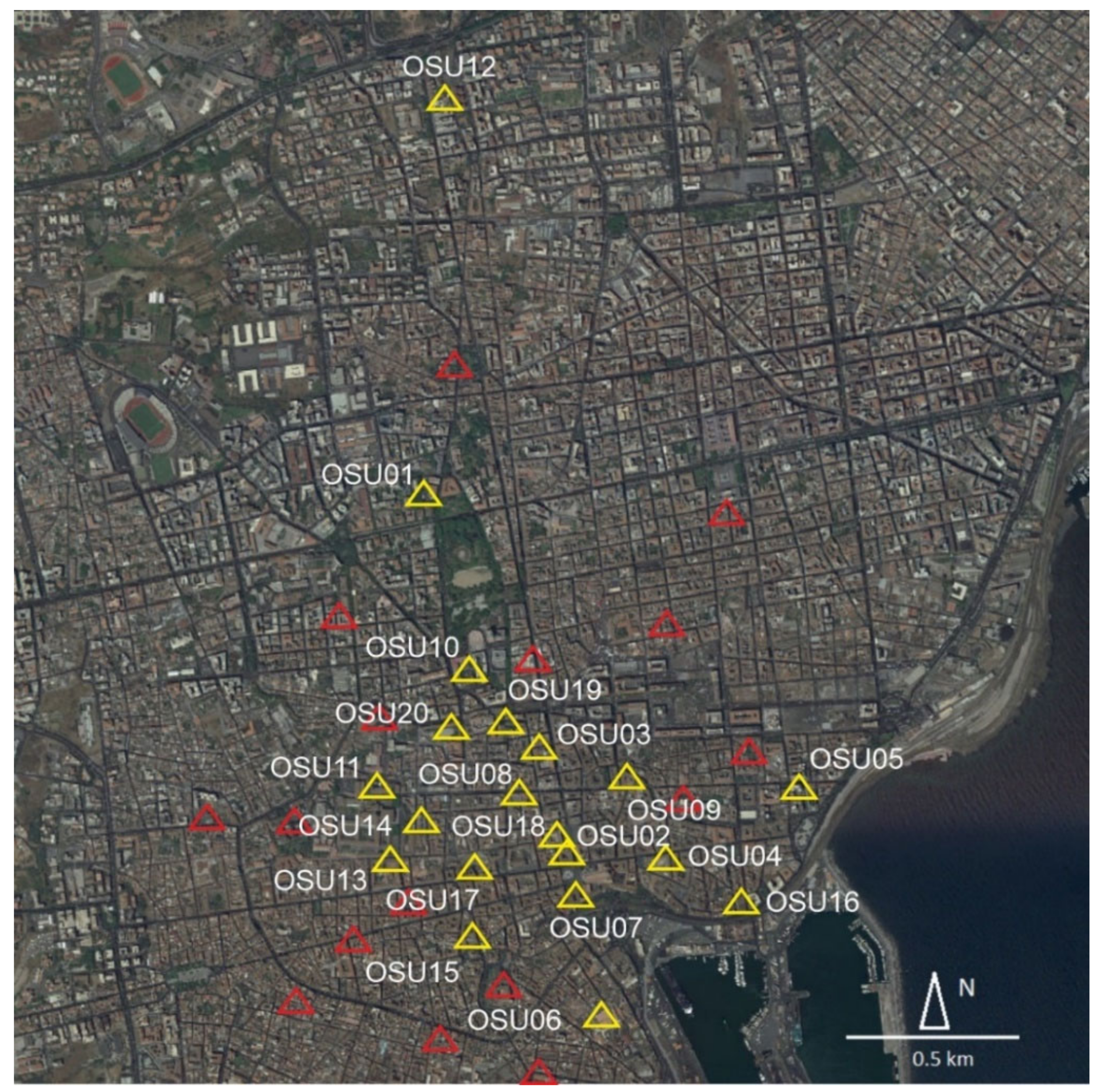

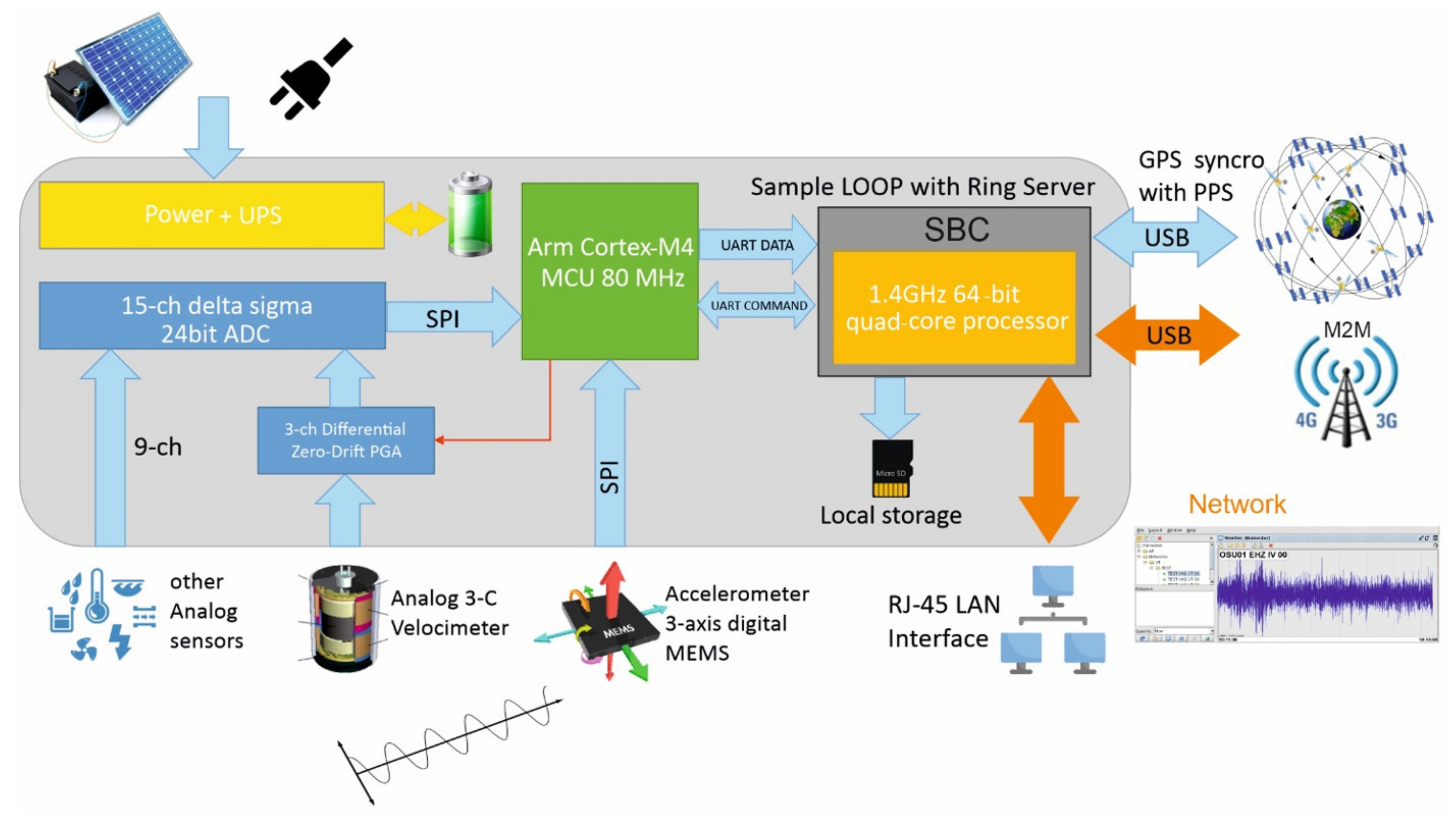
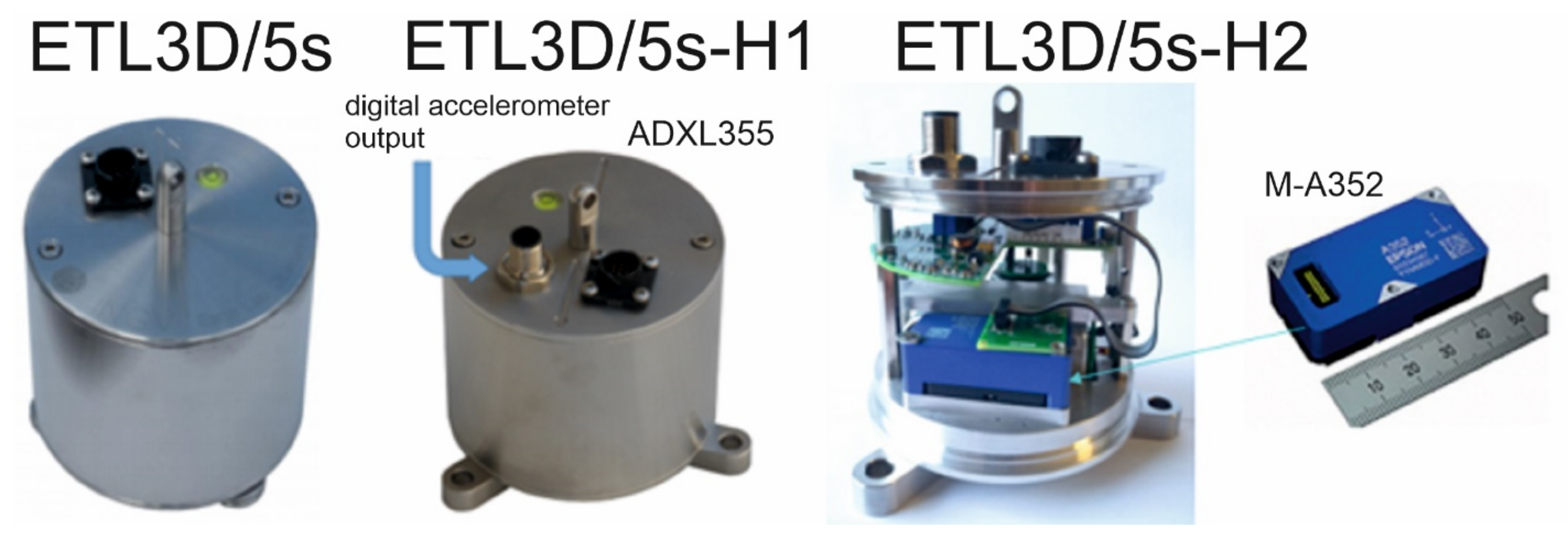
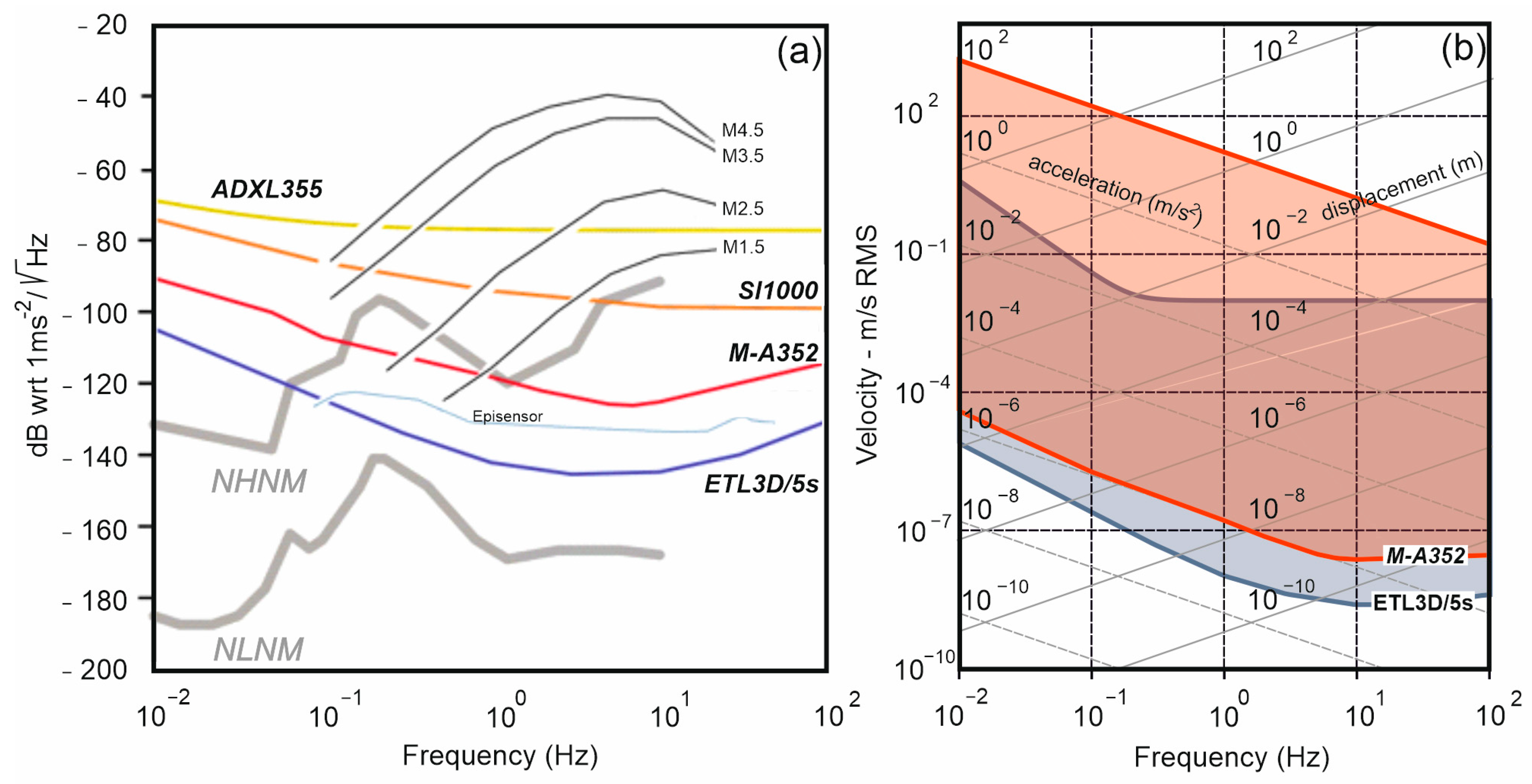
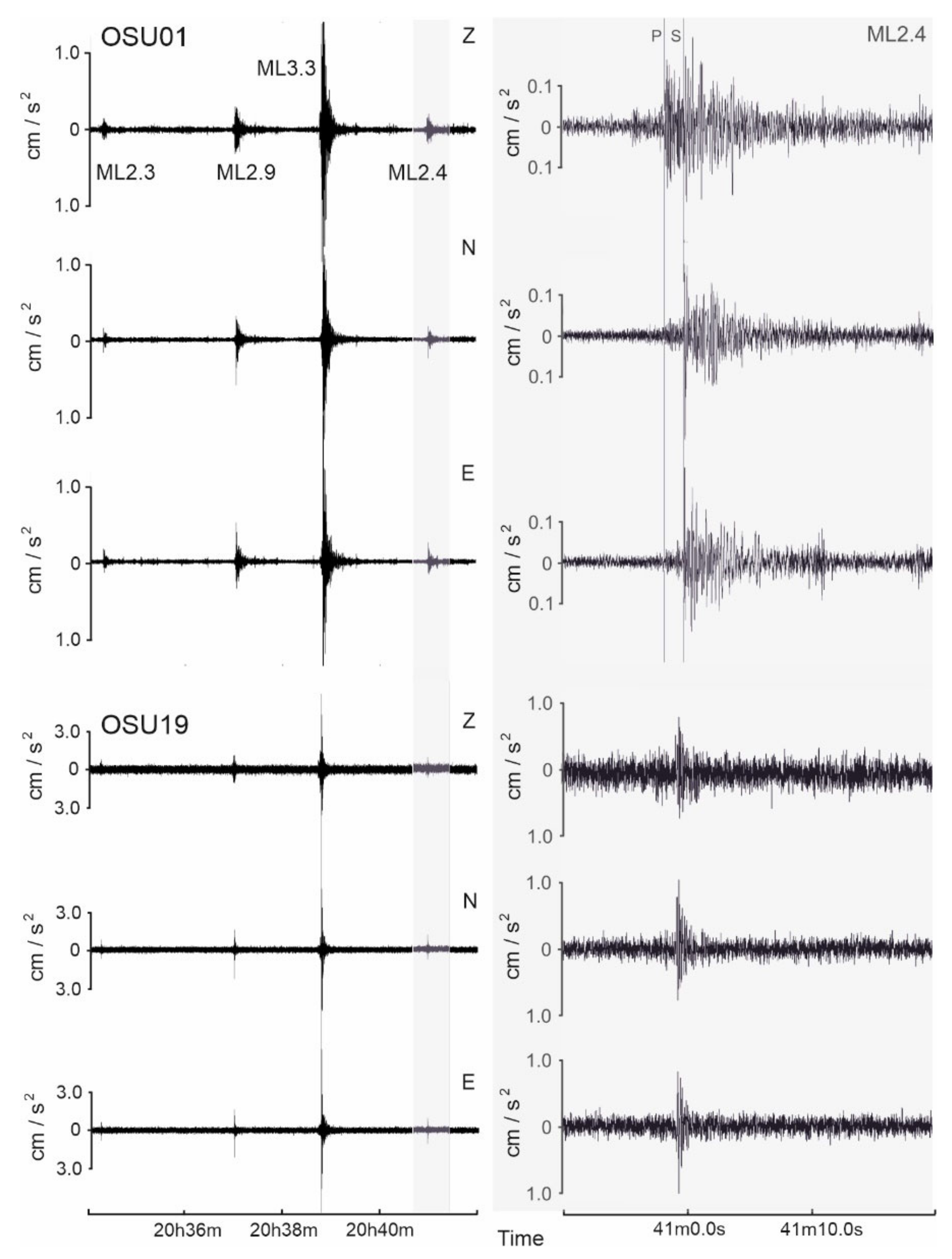
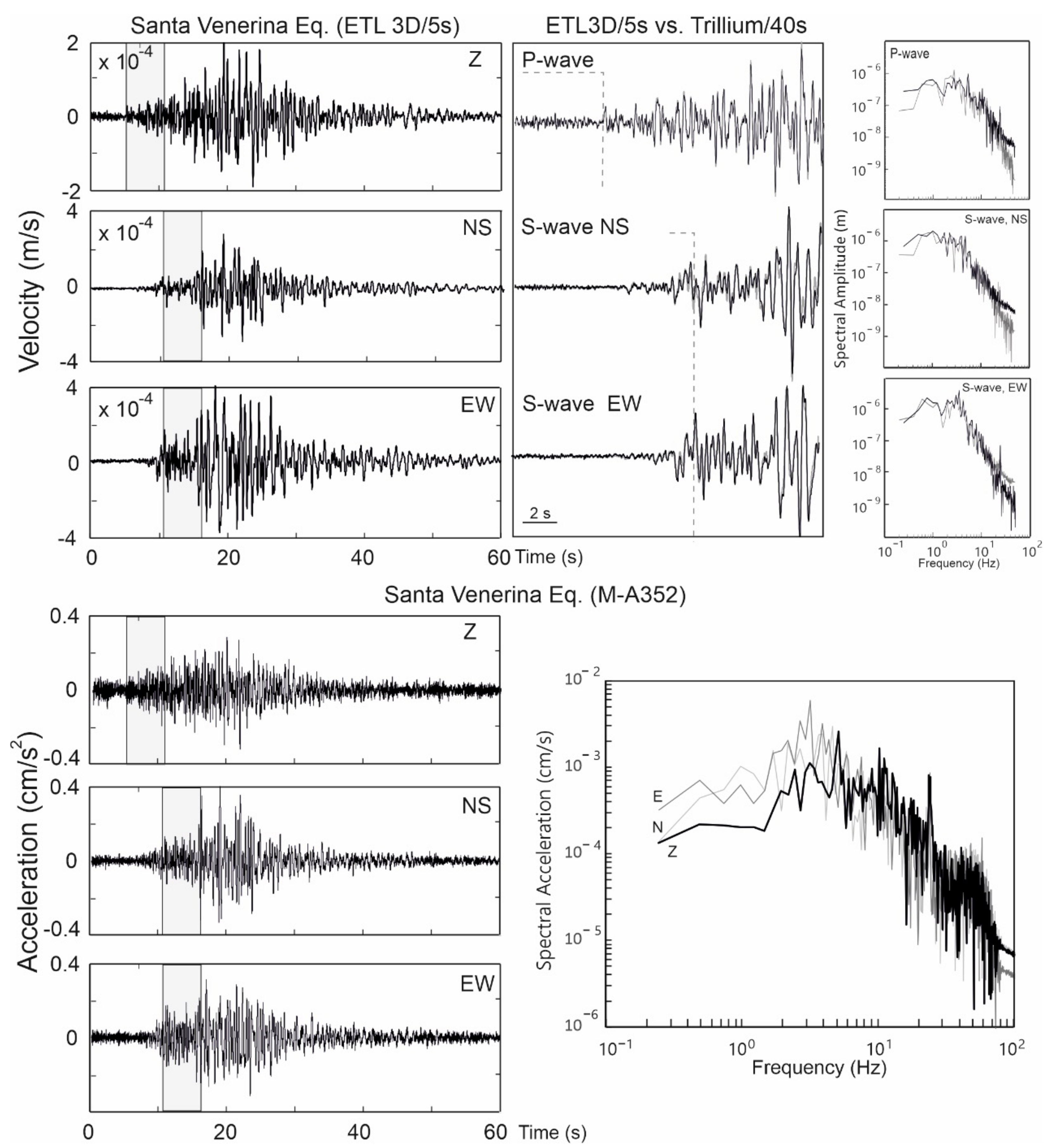
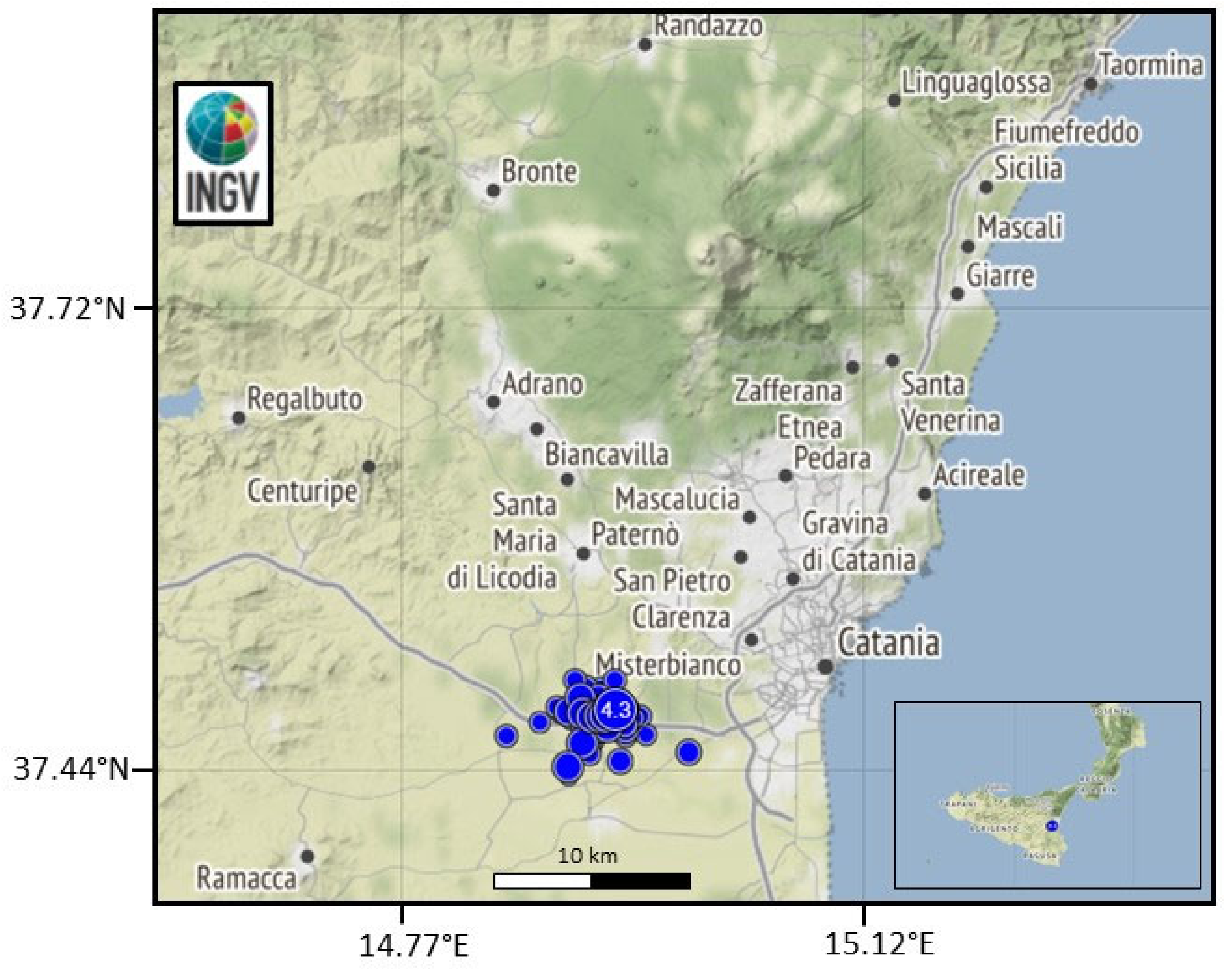

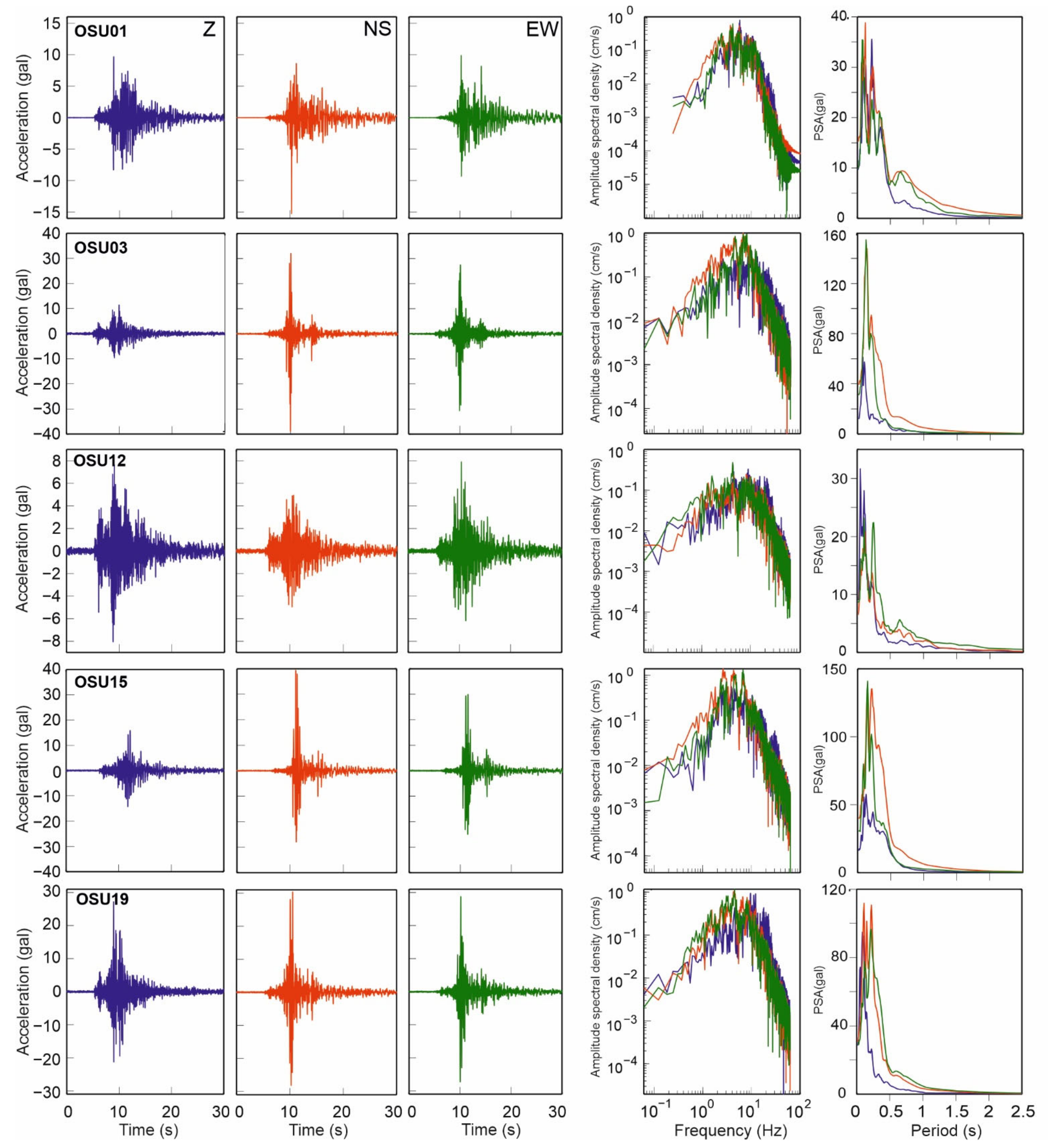
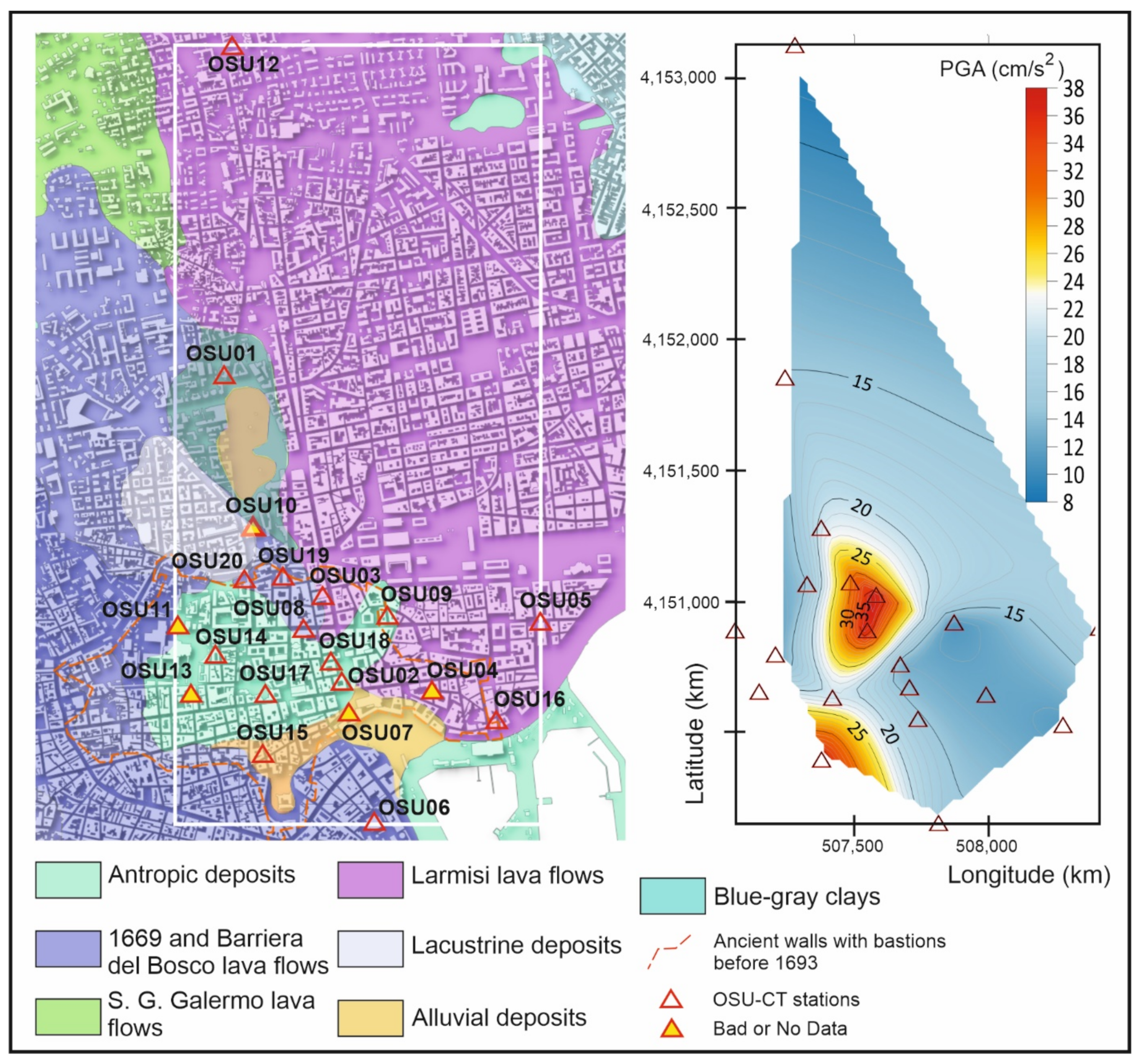
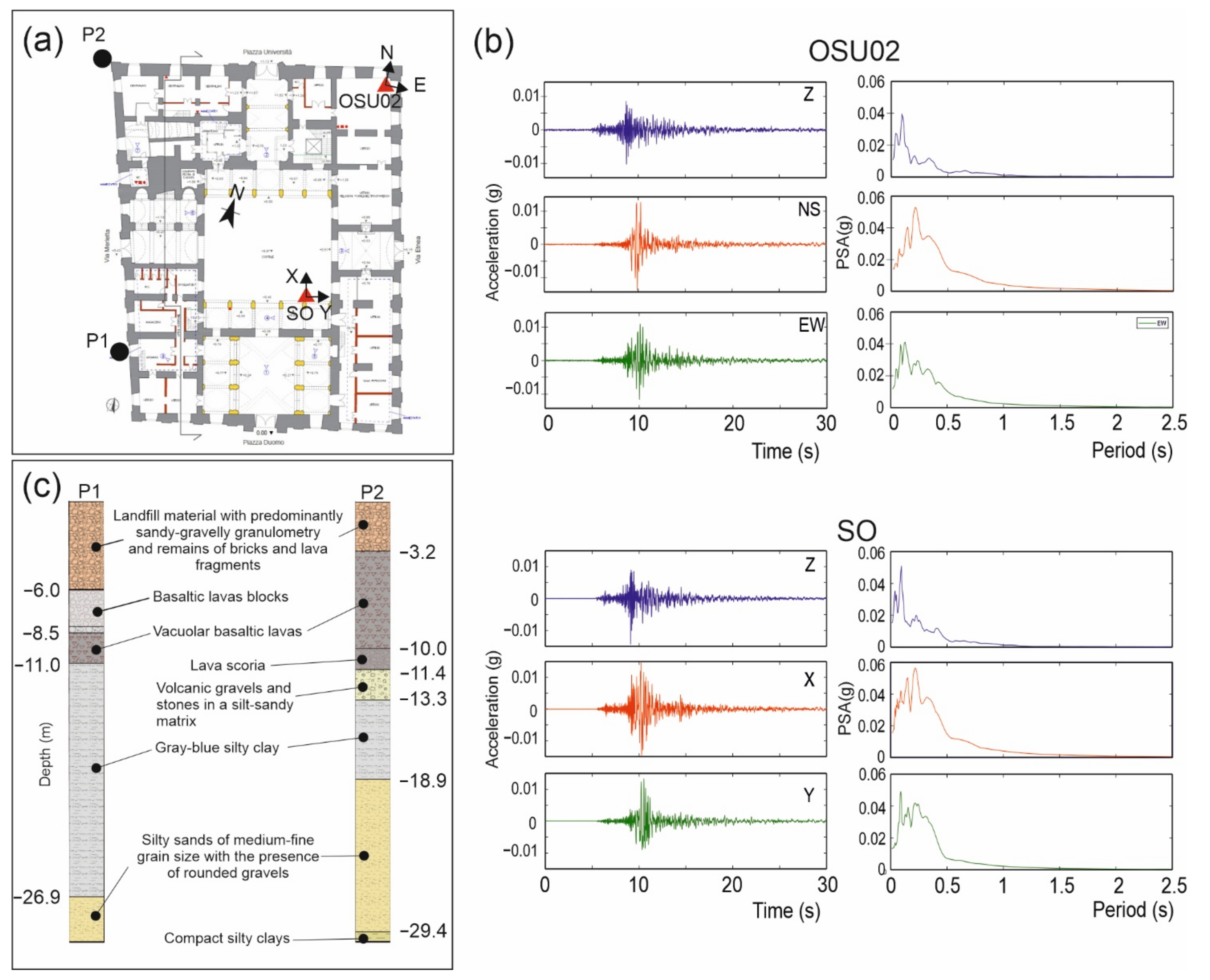
| Company | Product | Type | Number of Component | Noise Floor [µg/√Hz] | Sens [mV/g] | Sens. [µg/LSB] | Full Scale Range Dynamic Range | Bandwidht |
|---|---|---|---|---|---|---|---|---|
| Analog Device | ADXL355 | Digital 20 bit MEMS | 3 | 25 at ±2 g | 3.9 | ±2 g to ±8 g ~90 dB | 1–1000 Hz | |
| Epson | M-A352 | Digital 30 bit MEMS | 3 | 0.2 at 0.2–40 Hz (±15 g) | 0.06 | ± 15 g ~123 dB | 0–460 Hz | |
| Colibrys | SI1000 | Analog MEMS | 1 | 0.7 at 0.1–100 Hz | 900 | ± 3 g 108.5 dB (0.1–100 Hz) | 0–500 Hz (±3 g) | |
| Kinemetrics | Episensor ES-T | Force Balance | 3 | 0.06 at 1 Hz (±0.25 g) | 10,000 (±2.5 V) | ± 0.25 g to ±4 g 155 dB | 0–200 Hz | |
| Piezotronics | PCB393B12 | Analog Piezoelectric | 1 | 1.30 at 1 Hz, 0.32 at 10 Hz, 0.1 at 100 Hz | 10,000 | ±0.5 g | 0.15–1000 Hz | |
| Piezotronics | PCB393B04 | Analog Piezoelectric | 1 | 0.3 at 1 Hz, 0.1 at 10 Hz, 0.04 at 100 Hz | 1000 | ±5 g | 0.06–450 Hz |
| Station | Comp | PGA (gal) | Epicentral Distance (km) | Accelerometer | Location |
|---|---|---|---|---|---|
| OSU01 | HNZ | 9.662 | 14.8375 | Epson M-A352 | INGV-OE |
| OSU01 | HNN | 15.244 | 14.8375 | ||
| OSU01 | HNE | 9.849 | 14.8375 | ||
| OSU02 | HNZ | 10.270 | 15.0731 | ADXL355 | P.zzo degli Elefanti |
| OSU02 | HNN | 13.775 | 15.0731 | ||
| OSU02 | HNE | 11.527 | 15.0731 | ||
| OSU03 | HNZ | 11.764 | 15.0048 | ADXL355 | P.zzo Minoriti |
| OSU03 | HNN | 38.514 | 15.0048 | ||
| OSU03 | HNE | 31.144 | 15.0048 | ||
| OSU05 | HNZ | 8.339 | 15.8086 | ADXL355 | P.zzo Gandolfo |
| OSU05 | HNN | 9.033 | 15.8086 | ||
| OSU05 | HNE | 18.181 | 15.8086 | ||
| OSU06 | HNZ | 7.937 | 15.1566 | ADXL355 | Centro Polifunzionale Zurria |
| OSU06 | HNN | 16.070 | 15.1566 | ||
| OSU06 | HNE | 10.354 | 15.1566 | ||
| OSU08 | HNZ | 14.300 | 14.9329 | ADXL355 | P.zzo Attività Produttive |
| OSU08 | HNN | 37.740 | 14.9329 | ||
| OSU08 | HNE | 26.229 | 14.9329 | ||
| OSU09 | HNZ | 4.141 | 15.2780 | ADXL355 | P.zzo Urbanistica |
| OSU09 | HNN | 10.852 | 15.2780 | ||
| OSU09 | HNE | 7.581 | 15.2780 | ||
| OSU12 | HNZ | 7.960 | 15.1933 | ADXL355 | Villa Zingali Tetto |
| OSU12 | HNN | 5.007 | 15.1933 | ||
| OSU12 | HNE | 7.930 | 15.1933 | ||
| OSU14 | HNZ | 7.558 | 14.5967 | ADXL355 | ARPA |
| OSU14 | HNN | 11.427 | 14.5967 | ||
| OSU14 | HNE | 9.581 | 14.5967 | ||
| OSU15 | HNZ | 16.108 | 14.7061 | ADXL355 | Santa Chiara Anagrafe |
| OSU15 | HNN | 37.384 | 14.7061 | ||
| OSU15 | HNE | 29.374 | 14.7061 | ||
| OSU16 | HNZ | 4.386 | 15.6155 | ADXL355 | Politiche Sociali |
| OSU16 | HNN | 10.240 | 15.6155 | ||
| OSU16 | HNE | 11.335 | 15.6155 | ||
| OSU17 | HNZ | 8.217 | 14.7819 | ADXL355 | Teatro Greco |
| OSU17 | HNN | 20.636 | 14.7819 | ||
| OSU17 | HNE | 10.611 | 14.7819 | ||
| OSU18 | HNZ | 8.454 | 15.0525 | ADXL355 | P.zzo Università |
| OSU18 | HNN | 11.714 | 15.0525 | ||
| OSU18 | HNE | 12.948 | 15.0525 | ||
| OSU19 | HNZ | 26.440 | 14.9180 | ADXL355 | Villa Cerami |
| OSU19 | HNN | 29.703 | 14.9180 | ||
| OSU19 | HNE | 28.397 | 14.9180 | ||
| OSU20 | HNZ | 11.504 | 14.7614 | ADXL355 | Ex Chiesa Purità |
| OSU20 | HNN | 13.591 | 14.7614 | ||
| OSU20 | HNE | 14.840 | 14.7614 |
Publisher’s Note: MDPI stays neutral with regard to jurisdictional claims in published maps and institutional affiliations. |
© 2022 by the authors. Licensee MDPI, Basel, Switzerland. This article is an open access article distributed under the terms and conditions of the Creative Commons Attribution (CC BY) license (https://creativecommons.org/licenses/by/4.0/).
Share and Cite
Patanè, D.; Tusa, G.; Yang, W.; Astuti, A.; Colino, A.; Costanza, A.; D’Anna, G.; Di Prima, S.; Fertitta, G.; Mangiagli, S.; et al. The Urban Seismic Observatory of Catania (Italy): A Real-Time Seismic Monitoring at Urban Scale. Remote Sens. 2022, 14, 2583. https://doi.org/10.3390/rs14112583
Patanè D, Tusa G, Yang W, Astuti A, Colino A, Costanza A, D’Anna G, Di Prima S, Fertitta G, Mangiagli S, et al. The Urban Seismic Observatory of Catania (Italy): A Real-Time Seismic Monitoring at Urban Scale. Remote Sensing. 2022; 14(11):2583. https://doi.org/10.3390/rs14112583
Chicago/Turabian StylePatanè, Domenico, Giuseppina Tusa, William Yang, Antonio Astuti, Antonio Colino, Antonio Costanza, Giuseppe D’Anna, Sergio Di Prima, Gioacchino Fertitta, Salvatore Mangiagli, and et al. 2022. "The Urban Seismic Observatory of Catania (Italy): A Real-Time Seismic Monitoring at Urban Scale" Remote Sensing 14, no. 11: 2583. https://doi.org/10.3390/rs14112583
APA StylePatanè, D., Tusa, G., Yang, W., Astuti, A., Colino, A., Costanza, A., D’Anna, G., Di Prima, S., Fertitta, G., Mangiagli, S., Martino, C., & Torrisi, O. (2022). The Urban Seismic Observatory of Catania (Italy): A Real-Time Seismic Monitoring at Urban Scale. Remote Sensing, 14(11), 2583. https://doi.org/10.3390/rs14112583






